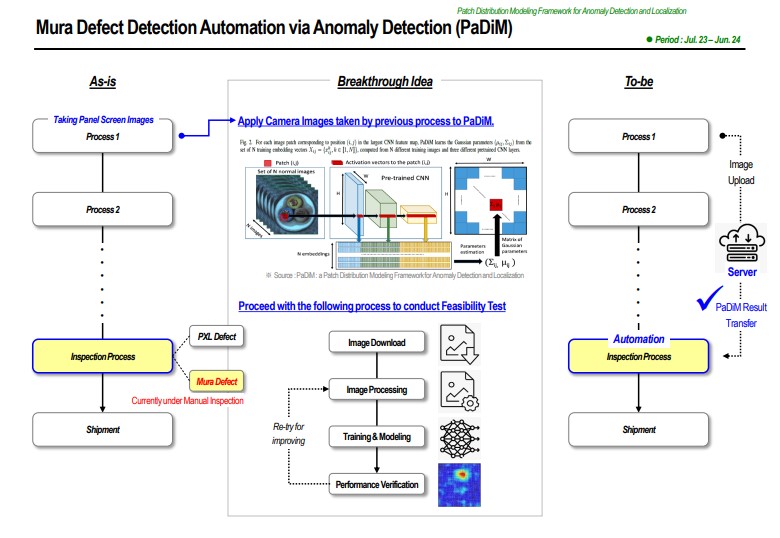
Hello! I am a Senior Engineer with 9 years of experience in the WOLED Manufacturing Inspection Process at LG Display Co., Ltd.
Over the past decade, I have specialized in designing and optimizing inspection systems that ensure the highest display quality.
My ultimate goal is to fully automate the inspection process through advanced AI technologies, minimizing human intervention while maximizing efficiency and accuracy.
To achieve this goal, I have been actively exploring key research areas such as (1) Continual Learning and (2) Computer Vision,
leveraging image data to develop more intelligent and robust inspection solutions.
Warning
Problem: The current name of your GitHub Pages repository ("Solution: Please consider renaming the repository to "
http://".
However, if the current repository name is intended, you can ignore this message by removing "{% include widgets/debug_repo_name.html %}" in index.html.
Action required
Problem: The current root path of this site is "baseurl ("_config.yml.
Solution: Please set the
baseurl in _config.yml to "Education
-
 Korea UniversityMaster Degree Course of AI
Korea UniversityMaster Degree Course of AI
(Full-time)Sep. 2025 - Aug. 2027 (Expected) -
 SungKyunKwan UniversityB.S. in Electronic and Electric EngineeringMar. 2010 - Aug. 2016
SungKyunKwan UniversityB.S. in Electronic and Electric EngineeringMar. 2010 - Aug. 2016
Work Experience
-
 LG Display Co.,LtdSenior Engineer of WOLED Manufacture
LG Display Co.,LtdSenior Engineer of WOLED Manufacture
Inspection ProcessJul. 2016 - Present
Honors & Awards
-
Selected as Degree Dispatcher (@LG Display)2024
-
Selected as Core Employee (@LG Display)2023 - Present
Projects

Mura Defect Detection Automation via Anomaly Detection (PaDiM)
Completed (setup in 2025) Jul. 2023 - Jun. 2024
To detect Mura defect automatically, PaDiM, that is a type of Anomaly Detection, was tested.
1. [Feasibility Test] at now, Mura defect is currently only detected under manual inspection. But in previous process,
there is process of making screen images by camera. By using these images, test involved Image Download, Image Processing, Training & Modeling,
and Performance Verification. It is concluded that PaDiM will be good solution for automating to detect.
2. [Optimizing Image Processing] When taking an image in the previous process, images may be rotated or curved due to many reasons.
If these images are cut into same size and pattern without image processing, not only miss-detect will occur in the cut location,
but also over-detect will occur due to Black data. To improve this problem, a Python module for image processing was developed.
that module find edges through contour approximation, and rotation and curve are improved through perspective transform.
In conclusion, PaDiM Accuracy is improved. (OK Accuracy : 11% → 69% / NG Accuracy : 29% → 93%)
Mura Defect Detection Automation via Anomaly Detection (PaDiM)
Completed (setup in 2025) Jul. 2023 - Jun. 2024
To detect Mura defect automatically, PaDiM, that is a type of Anomaly Detection, was tested.
1. [Feasibility Test] at now, Mura defect is currently only detected under manual inspection. But in previous process,
there is process of making screen images by camera. By using these images, test involved Image Download, Image Processing, Training & Modeling,
and Performance Verification. It is concluded that PaDiM will be good solution for automating to detect.
2. [Optimizing Image Processing] When taking an image in the previous process, images may be rotated or curved due to many reasons.
If these images are cut into same size and pattern without image processing, not only miss-detect will occur in the cut location,
but also over-detect will occur due to Black data. To improve this problem, a Python module for image processing was developed.
that module find edges through contour approximation, and rotation and curve are improved through perspective transform.
In conclusion, PaDiM Accuracy is improved. (OK Accuracy : 11% → 69% / NG Accuracy : 29% → 93%)

Defect Classification Automation through Trained Classification Model
Completed Jul. 2022 - Dec. 2022
There is camera inspection process in which pixel defects can be detected.
By using thumbnail images, classfication model was trained and applied at this process to classify different types of defects label including over-defect.
In conclusion, This model can be classified with 95% accuracy and over-detect can be improved by more than 70%.
Defect Classification Automation through Trained Classification Model
Completed Jul. 2022 - Dec. 2022
There is camera inspection process in which pixel defects can be detected.
By using thumbnail images, classfication model was trained and applied at this process to classify different types of defects label including over-defect.
In conclusion, This model can be classified with 95% accuracy and over-detect can be improved by more than 70%.